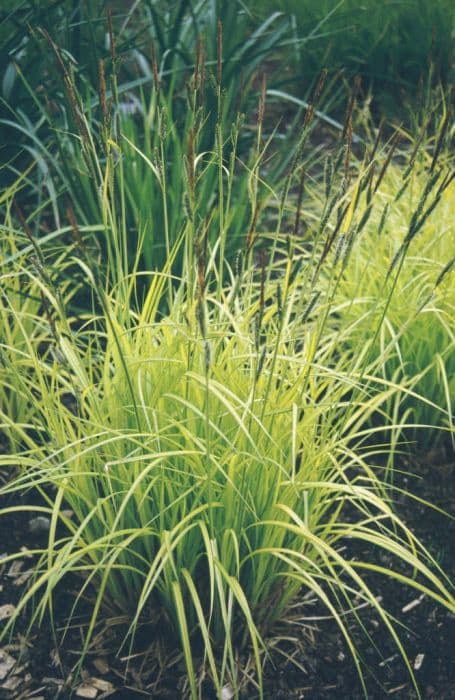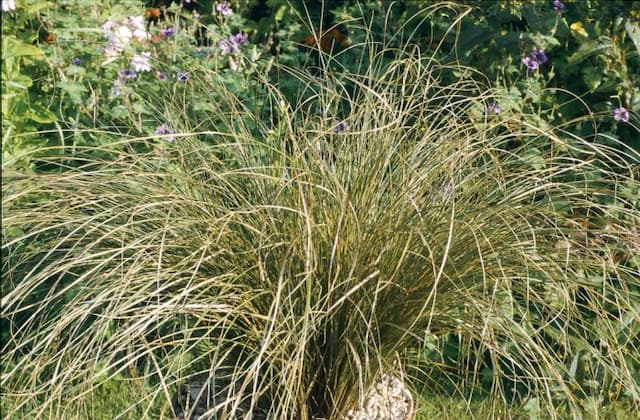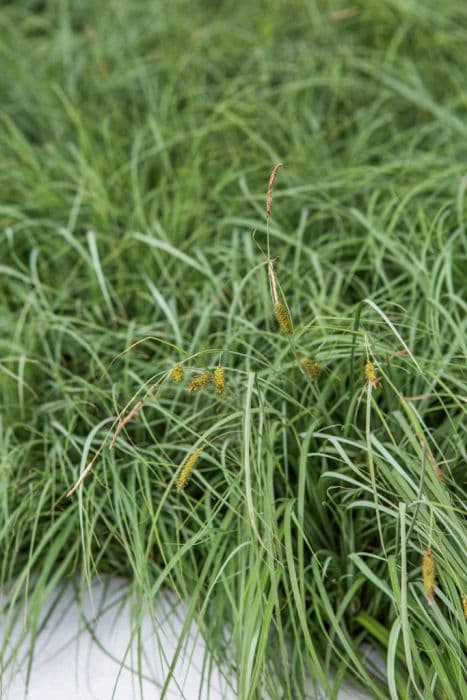Berkeley Sedge Carex divulsa

ABOUT
Carex divulsa, commonly known as Berkeley sedge, is a lush, clump-forming perennial grass-like plant. This species boasts slender, arching, bright green leaves which give the plant a cascading, feathery appearance. The foliage texture is fine, contributing to its dense and tufted look. The leaves emerge from a central point at the base, which allows the blades to spread out gracefully in all directions, presenting an overall fountain-like shape. During its flowering period, Berkeley sedge produces inconspicuous brown flower spikes that blend in with the greenery. These spikes give way to small seed capsules as the season progresses. The plant's subtle blooms are often overshadowed by its vibrant green foliage, which remains visually appealing throughout the growing season. Overall, the Berkeley sedge has a natural and unassuming aesthetic that can easily blend into various garden styles, from formal borders to informal, naturalized areas.
About this plant
 Names
NamesFamily
Cyperaceae.
Synonyms
Berkeley Sedge, European Meadow Sedge, Grey Sedge, Foothill Sedge.
Common names
Carex guestphalica, Carex tumidula, Carex divulsa subsp. leersii, Carex leersii.
 Toxicity
ToxicityTo humans
The plant commonly known as Berkeley sedge (Carex divulsa) is not known to be toxic to humans. There are no known symptoms of poisoning as it is not considered poisonous. Ingesting parts of the plant is not typically associated with any adverse health consequences for humans.
To pets
Berkeley sedge (Carex divulsa) is also not known to be toxic to pets. It does not pose a risk of poisoning, and there are no specific symptoms of poisoning associated with this plant. Consuming parts of the plant should not result in any harmful effects for pets.
 Characteristics
CharacteristicsLife cycle
Perennials
Foliage type
Evergreen
Color of leaves
Green
Height
2 feet [60 cm]
Spread
2 feet [60 cm]
Plant type
Herb
Hardiness zones
5-9
Native area
Europe
Benefits
 General Benefits
General Benefits- Erosion Control: Carex divulsa has a robust root system which helps stabilize soil and prevent erosion.
- Habitat for Wildlife: It provides shelter and food for various forms of wildlife, including insects and birds.
- Aesthetic Appeal: The grass-like foliage and texture of this sedge adds visual interest to gardens and landscapes.
- Low Maintenance: Once established, Carex divulsa requires minimal care, making it ideal for low-maintenance landscapes.
- Drought Tolerance: The plant is relatively drought-tolerant, which reduces the need for frequent watering.
- Versatility in Landscaping: It can be used in a variety of landscape designs, from formal gardens to naturalized areas.
- Tolerance of Different Soil Types: Carex divulsa can thrive in a range of soil conditions, from clay to sandy soils.
- Cold Hardy: This sedge is able to withstand cold temperatures, making it suitable for gardens in cooler climates.
- Lawn Alternative: It can serve as a lower-maintenance and eco-friendly alternative to traditional grass lawns.
- Supports Biodiversity: By incorporating Carex divulsa into the landscape, one can contribute to the ecological diversity of the area.
 Medical Properties
Medical PropertiesThis plant is not used for medical purposes.
 Air-purifying Qualities
Air-purifying QualitiesThis plant is not specifically known for air purifying qualities.
 Other Uses
Other Uses- Grassland Sedge can serve as a natural lawn alternative, requiring less maintenance and watering than traditional grass species.
- It can be used in basketry and weaving projects due to its long, sturdy blades that can be dried and treated for craft purposes.
- The dense root system of Grassland Sedge is effective for erosion control on slopes and riverbanks, helping to stabilize soil and prevent washouts.
- This sedge is suitable for use in green roofs, where its tolerance of a variety of conditions can contribute to the diversity and resilience of the rooftop plant community.
- Its fibrous foliage can be used as a natural stuffing material for small handcrafted pillows or toys when dried properly.
- The seeds of the Grassland Sedge are sometimes collected by enthusiasts for propagation to cultivate new plants or create seed mixes for natural landscaping.
- In landscape design, the plant can be used to create a "river" or "stream" effect in dry creek beds, due to its graceful, flowing appearance.
- Its attractive, tufted form can be incorporated into ornamental grass gardens, providing contrast against other plants with different textures and forms.
- Grassland Sedge can be a natural dye source for textiles, though it provides subtle coloring and is not commonly used for this purpose.
- Because of its hardiness, the sedge can be planted in urban settings to provide green spaces that require little care amidst the concrete and asphalt.
Interesting Facts
 Feng Shui
Feng ShuiThe Berkeley sedge is not used in Feng Shui practice.
 Zodiac Sign Compitability
Zodiac Sign CompitabilityThe Berkeley sedge is not used in astrology practice.
 Plant Symbolism
Plant Symbolism- Adaptability: Carex divulsa, commonly known as the Berkeley sedge, thrives in a wide range of habitats, symbolizing the ability to adapt to various environments and circumstances.
- Resilience: As a hardy grass that can withstand different weather conditions and soil types, Berkeley sedge represents resilience and enduring through challenges.
- Natural Beauty: With its simple yet elegant foliage, Berkeley sedge embodies the concept of natural, understated beauty that doesn't need to be flashy to be appreciated.
- Growth: The grass's spreading nature signifies growth and expansion, both personally and in a garden or ecosystem.
 Water
WaterThe Berkeley Sedge (Carex divulsa) should be watered deeply but infrequently to encourage a strong root system. For young plants, watering twice a week may be necessary, while established plants prefer drier conditions and should be watered every other week, depending on climate and soil type. Use approximately 1 gallon of water per plant for each watering session to ensure the moisture reaches deep into the soil. During hot, dry spells, you may need to water more frequently, but always allow the soil to dry out slightly between waterings. Over-watering can lead to root rot, so it's important to assess soil moisture before watering.
 Light
LightBerkeley Sedge thrives in a variety of light conditions, from full sun to partial shade. It is best suited to spots that receive morning sun and afternoon shade or dappled sunlight throughout the day. Avoid planting it in deep shade, as this can reduce the plant's vigor and density.
 Temperature
TemperatureBerkeley Sedge is hardy and tolerates a wide range of temperatures, thriving best between 60°F and 75°F. It can survive minimum temperatures down to about 0°F, making it suitable for many temperate climates. Protecting the plant from extreme heat or cold is advisable to maintain its health and appearance.
 Pruning
PruningPruning Berkeley Sedge is beneficial for removing old foliage and encouraging fresh growth. Trim back dead or brown leaves in early spring before new growth starts. This plant does not require frequent pruning; an annual tidy-up to remove spent leaves is usually enough. The best time for pruning is late winter or early spring.
 Cleaning
CleaningAs needed
 Soil
SoilThe best soil mix for Berkeley sedge (Carex divulsa) is well-draining, fertile, and loamy with the ability to maintain slight moisture. It should ideally have a pH between 5.5 and 7.5. A mixture composed of garden soil, compost, and perlite or sand would serve as an excellent medium for this plant's growth.
 Repotting
RepottingBerkeley sedge (Carex divulsa) does not require frequent repotting and typically can be repotted every two to three years. The main reason to repot would be to divide the plant to manage its size and rejuvenate its growth.
 Humidity & Misting
Humidity & MistingBerkeley sedge (Carex divulsa) prefers moderate humidity levels but is quite adaptable and can tolerate a range of humidity conditions. There is no specific humidity requirement, but ensuring good air circulation helps in maintaining its health.
 Suitable locations
Suitable locationsIndoor
Place Berkeley sedge in bright, indirect light with well-draining soil.
Outdoor
Plant Berkeley sedge in part shade to full sun with moist soil.
Hardiness zone
5-9 USDA
 Life cycle
Life cycleThe life of Carex divulsa, commonly known as Grey Sedge, begins with seed germination, which occurs in moist soil conditions often in spring. The seedlings develop into clumps of grass-like foliage, featuring narrow leaves that are rolled inward at the bud stage, a characteristic trait of sedges. As the plant matures, it develops a dense root system and flowering stems called culms that rise above the foliage in late spring to early summer. The flowers of Grey Sedge are wind-pollinated and are not showy, comprising of small, greenish-brown spikelets. After pollination, the plant produces fruits called perigynia, which house the seeds that will disperse to produce new plants. In the autumn, the plant may die back slightly but as a perennial, it survives through the winter and resumes growth the following spring.
 Propogation
PropogationPropogation time
Spring to summer
The most popular method of propagating Carex divulsa, commonly known as Berkeley sedge, is through division. This technique is typically undertaken in late winter to early spring before new growth begins. To propagate by division, one would carefully dig up an established clump of Berkeley sedge, ensuring to keep a good portion of the root system intact with each division. The clump should then be gently separated into smaller sections, each with several growing points. These individual sections can then be replanted immediately in well-draining soil at the same depth they were growing originally. It is important to water the new divisions thoroughly after planting to help establish the roots. With proper care, these new plants will start to grow and establish themselves over the following growing season.









